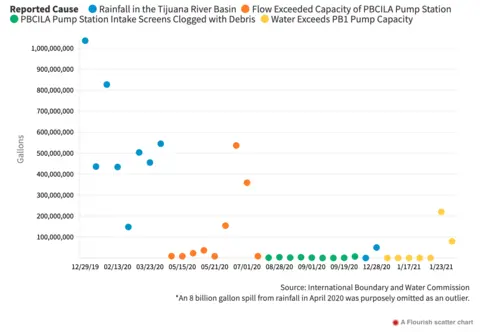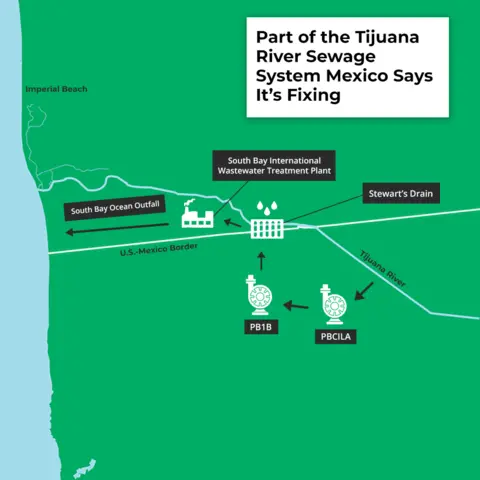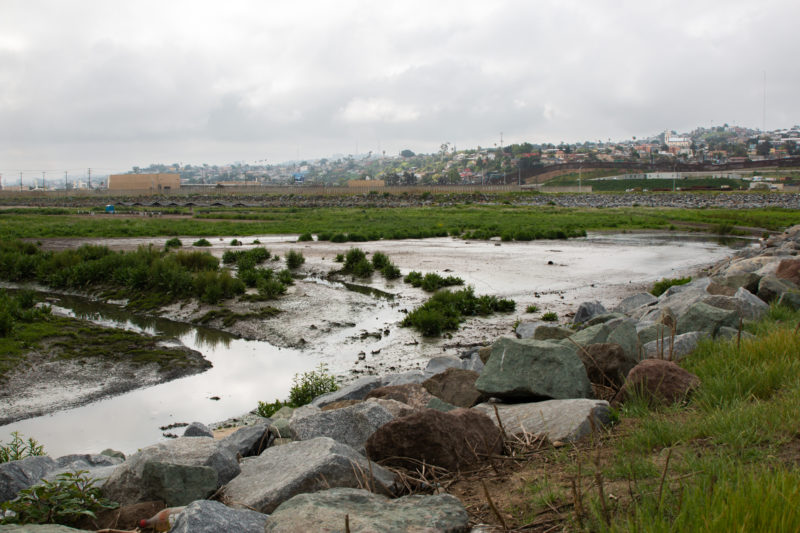
Like a giant garbage disposal, three huge new green pipes sit on Mexico’s side of the border, shredding trash in the Tijuana River that would otherwise jam this critical piece of the city’s wastewater system that caused spills on the United States side.
“It’s a dream come true,” said Rigoberto Laborín Valdez, the undersecretary of sanitation and the protection of water in Baja California, gazing through a construction fence at the replacement pump station he brought to fruition.

Laborín Valdez, a veteran from the private water treatment sector in Mexico, said Baja’s Gov. Jaime Bonilla charged him with stopping the sewage spills into Imperial Beach on the U.S. side.
And Mexico is going to do it on its own, he said, it doesn’t need any help from the U.S. Environmental Protection Agency, which has $300 million from the new NAFTA deal (called the U.S.-Mexico-Canada Agreement or USMCA) to fix the problem that’s existed basically since the current border was drawn.
Sewage from Mexico along with other pollutants has inflicted South Bay waters for decades. Beaches were closed in 2020 for almost nine months, officials say. So Laborín Valdez’ big claim that Mexico is fixing the problem would be welcome news, and it’s something a lot of Mexican leaders have been touting recently.
There is some reason to believe it’s true. Mexico has added new infrastructure that’s been a major improvement and has plans to fix remaining problems. But U.S. officials say there’s still sewage flowing, and the beaches are still closed.
The city of Tijuana’s sewage and trash come from different places but a lot of it ends up in the Tijuana River, which flows through the city and into the United States. Mexico has long had a diversion in place to move the water from the river to a pump station that delivers it either to a treatment plant in the United States or one in Mexico.
That’s called the PB-CILA pump station but its pipes were too small to handle the water and constantly clogged by garbage. Laborín Valdez said PB-CILA’s already brittle system depended on one guy who was responsible for cleaning trash away from a screen over a drain that leads to PB-CILA.
“Two countries were dependent on Abel showing up to work,” Laborín Valdez said.
That drain became clogged with trash nine times between Aug.1 and Nov. 3, 2020, according to data from the International Boundary and Water Commission, a binational body that enforces border water treaties. When that happens (or if it rains too much), PB-CILA shuts down and the water is allowed to run free, which often overwhelms the capacity of the treatment plant.
What’s Causing Sewage Spills in the TJ River?

*An 8 billion gallon spill from rainfall in April 2020 was purposely omitted as an outlier.
“You can’t stop a river,” Laborín Valdez said.
Laborín Valdez laid out a grand plan to stop sewage from flowing into San Diego last fall. It involved buying American-made pumps equipped with trash shredders.
By Nov. 11, Laborín Valdez’ new set of pipes was working on overdrive and the spill reports seemed to stop. For a while.
Though the pump station wasn’t getting clogged anymore, it lost electrical power twice on Dec. 13 and again on Dec. 16, reports show, causing over 3 million gallons of untreated sewage to spill.
But now, the biggest problem seems to be a different broken piece of the Tijuana River diversion system, a pump called PB-1B, which sends river water and sewage from the larger pump station across the international border to the South Bay International Wastewater Treatment Plant. When there’s too much water for that pump to handle, it spills out of a drain in the border wall, bypassing the treatment plant and into the Tijuana River Valley.

Both the United States and Mexico are supposed to pay for that fix. The North American Development Bank, where both countries put money to invest in international projects, said fixes to both PB-1B and its sister, called PB-1A, would cost about $13 million and would be split 50-50. The North American Development Bank expects that project to be approved in between April and June, said spokesman Jesse Hereford.
EPA was scheduled to give a public update Friday at 10 a.m. on what it plans to do with that $300 million from the USMCA. It could be used to fund projects on both sides of the border, but there’s pressure from officials on the U.S. side to build a domestic solution (either another wastewater treatment plant or something else).
“It’s U.S. taxpayer money that should be spent on the U.S. side of the border on infrastructure that we can manage and control,” said Serge Dedina, mayor of Imperial Beach, the city closest to the border and that experiences months-long beach closures from the spills.
The San Diego County Board of Supervisors declared the Tijuana River Valley sewage problem a public health crisis for South Bay and coastal communities in February.
But Mexican officials have claimed over the past few months that they’ve stopped the spills into Imperial Beach. Bonilla advertised what he claims is his administration’s achievement through multiple Facebook Live broadcasts earlier this year.
“We’ve already resolved (the problem) on the U.S. side," Bonilla said on Feb. 3.
Bonilla claims the president of Mexico, Andrés Manuel López Obrador, asked him to find a solution back in 2018 when he was a Mexican senator.
“For many years, the contamination of the beaches presented a serious problem, without the attention it deserved from former administrations, the situation got worse when it reached the coast of Imperial Beach and converted into a binational problem,” he said over Facebook Live.
But Bonilla is not the only one touting achievements.
Jesus Luevano, who leads the Mexican version of the International Boundary and Water Commission, echoed his claims in a phone interview.
“We’ve improved PBCILA, which intercepts water that would go to the U.S., and we’ve prevented runoff through the Tijuana River into the U.S.,” Luevano said.
But the constant celebration of Baja officials met a challenge from another social media platform, a Twitter account from the other side of the border.
“If I get one more WhatsApp message or Tweet from officials in Mexico claiming the sewage crisis is ‘fixed’ I will lose my %#&@,” Dedina tweeted back on Jan 5.
At times, the disagreements have reached heated exchanges on different platforms between public servants from countries that should be working together.
After some Dedina comments, Bonilla accused him of trying to get the spotlight for political campaigns.
“We’re not going to allow a mayor to beat up Mexico because of his political aspirations, because he wants to be a senator,” Bonilla said during a Facebook Live broadcast in September.
In his previous political career, Bonilla served on the Otay Water District Board for more than a decade and led it at a time the district was embroiled in scandal.
Seems like things are looked at differently from each side of the border.
Many Mexican officials complain only the U.S. side of the Tijuana River sewage story is covered by the press.
“This issue is politicized when it is a technical problem solved only with a lot of effort,” Laborín Valdez said.
As of Thursday, Imperial Beach’s beaches were closed, confirmed Chris Helmer, the city’s environmental and natural resources director.
“I can’t wait for this problem to be fixed so I can spend my time working on something else … and surfing,” Dedina said Thursday.






